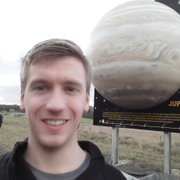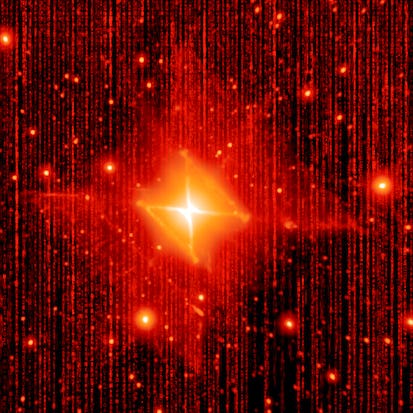- Level Professional
- المدة 24 ساعات hours
- الطبع بواسطة The University of Sydney
-
Offered by

عن
Science is undergoing a data explosion, and astronomy is leading the way. Modern telescopes produce terabytes of data per observation, and the simulations required to model our observable Universe push supercomputers to their limits. To analyse this data scientists need to be able to think computationally to solve problems. In this course you will investigate the challenges of working with large datasets: how to implement algorithms that work; how to use databases to manage your data; and how to learn from your data with machine learning tools. The focus is on practical skills - all the activities will be done in Python 3, a modern programming language used throughout astronomy. Regardless of whether you're already a scientist, studying to become one, or just interested in how modern astronomy works "under the bonnet', this course will help you explore astronomy: from planets, to pulsars to black holes. Course outline: Week 1: Thinking about data - Principles of computational thinking - Discovering pulsars in radio images Week 2: Big data makes things slow - How to work out the time complexity of algorithms - Exploring the black holes at the centres of massive galaxies Week 3: Querying data using SQL - How to use databases to analyse your data - Investigating exoplanets in other solar systems Week 4: Managing your data - How to set up databases to manage your data - Exploring the lifecycle of stars in our Galaxy Week 5: Learning from data: regression - Using machine learning tools to investigate your data - Calculating the redshifts of distant galaxies Week 6: Learning from data: classification - Using machine learning tools to classify your data - Investigating different types of galaxies Each week will also have an interview with a data-driven astronomy expert. Note that some knowledge of Python is assumed, including variables, control structures, data structures, functions, and working with files.الوحدات
Lesson 1: Introduction
1
Discussions
- Introduce yourself (optional)
1
Videos
- Thinking about data
Lesson 2: Course overview
1
External Tool
- Set up your online assessment
1
Videos
- Course overview
Lesson 3: Pulsars
1
Assignment
- Pulsars: test your understanding
1
Videos
- Pulsars
Lesson 4: Diving in - image stacking
1
External Tool
- Calculating the mean stack
1
Videos
- Diving in: imaging stacking
Lesson 5: The challenge: what went wrong?
1
Discussions
- How could you improve the algorithm?
1
Videos
- Challenge: the median doesn't scale
Lession 6: The solution: improving your method
1
External Tool
- Calculating the median stack
2
Videos
- The solution: improving your method
- Module summary
1
Readings
- Further reading
Bonus material: interview with an astronomer
1
Videos
- Interview with Aris Karastergiou
Lesson 1: Introduction
1
Discussions
- What scaling problems have you encountered?
1
Videos
- Big data makes things slow
Lesson 2: Supermassive black holes
1
Assignment
- Supermassive black holes: test your understanding
1
Videos
- Supermassive black holes
Lesson 3: Diving in - crossmatching
1
External Tool
- A naive cross-matcher
1
Videos
- What is cross-matching?
Lesson 4: Time complexity and scaling
1
Videos
- Evaluating time complexity
Lesson 5: A faster solution
1
External Tool
- Crossmatching with k-d trees
2
Videos
- A (much) faster algorithm
- Module summary
Bonus material: interview with an astronomer
1
Videos
- Interview with Brendon Brewer
Lesson 1: Introduction
1
Discussions
- Do you use databases in your work?
1
Videos
- Organising your data
Lesson 2: Exoplanets
1
Assignment
- Exoplanets - test your understanding
1
Videos
- Exoplanets
Lesson 3: Diving in - simple queries
1
External Tool
- Writing your own SQL queries
1
Videos
- Querying database with SQL
Lesson 4: More advanced SQL queries
1
Videos
- More advanced SQL
Lesson 5: Joining tables
1
External Tool
- Joining tables with SQL
1
Videos
- Joining tables in SQL
Lesson 6: Planets in the habitable zone
1
Videos
- Module summary
Bonus material: interview with an astronomer
1
Videos
- Interview with Jon Jenkins
Lesson 1: Introduction
1
Videos
- Managing your big datasets
Lesson 2: The lifecycle of stars
1
Assignment
- Stars - test your understanding
1
Videos
- The lifecycle of stars
Lesson 3: Diving in - databases
1
External Tool
- Setting up your own database
1
Videos
- Setting up your own database
Lesson 4: Exploring a star cluster
1
External Tool
- Combining SQL and Python
2
Videos
- Exploring a star cluster
- Module summary
Bonus material: interview with an astronomer
1
Videos
- Interview with Emily Petroff
Lesson 1: Introduction
1
Videos
- Learning from data
Lesson 2: The cosmological distance scale
1
Assignment
- Cosmological distances - test your understanding
1
Videos
- The cosmological distance scale
Lesson 3: Diving in - machine learning
1
External Tool
- Building a regression classifier
1
Videos
- What is machine learning?
Lesson 4: Decision trees
1
Videos
- Decision tree classifiers
Lesson 5: Estimating redshifts using regression
1
External Tool
- Improving and evaluating our classifier
2
Videos
- Estimating redshifts using regression
- Summary
Bonus material - interview with an astronomer
1
Videos
- Interview with Ashish Mahabal
Lesson 1: Introduction
1
Videos
- Classifying your data
Lesson 2: Types of galaxies
1
Assignment
- Galaxies - test your understanding
1
Videos
- Types of galaxies
Lesson 3: Diving in - morphological classification
1
Videos
- Morphological classification of galaxies
Lesson 4: Are decision trees good enough?
1
Discussions
- Reflection on galaxy classification
1
Videos
- Limitations of decision tree classifiers
1
Readings
- Classify some galaxies by hand!
Lesson 5: Ensemble classifiers
1
External Tool
- Exploring machine learning classification
2
Videos
- Improving our results with ensemble classifiers
- Module summary
Bonus material: interview with an astronomer
1
Videos
- Interview with Karen Masters
Auto Summary
Explore the data-driven world of modern astronomy with this engaging course on Coursera. Taught by experts, you'll learn to tackle large datasets, implement effective algorithms, and utilize databases and machine learning tools, all using Python 3. Over six weeks, dive into topics like pulsars, black holes, exoplanets, and galaxies. Ideal for aspiring scientists or enthusiasts with basic Python knowledge, the course offers flexible subscription options including Starter, Professional, and Paid. Join now to uncover the computational secrets of the universe!

Tara Murphy

Simon Murphy

